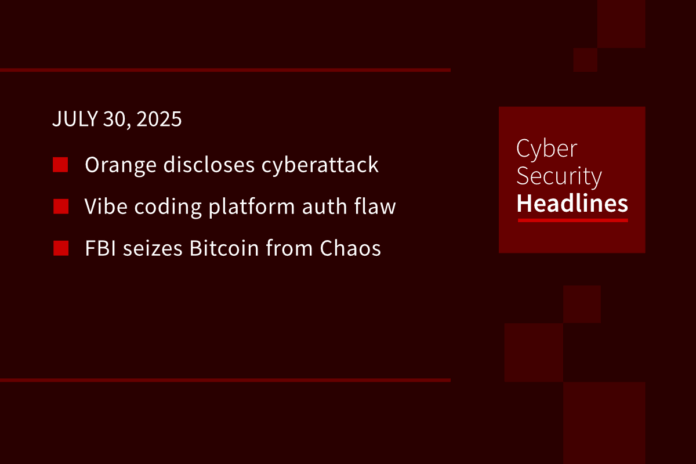Do you ever wonder how secure your information is when using online services? With ongoing developments in the world of cybersecurity, it’s essential to stay informed about the latest incidents that can impact both personal security and the broader landscape of digital safety. One recent event that has caught the attention of many is the hacking incident involving Telecom Orange. In this article, let’s break down what happened, the implications for the telecommunications industry, and the evolving methods of cybercriminals.

This image is property of media.cisoseries.com.
The Telecom Orange Cyberattack
Overview of the Incident
Telecom Orange, a major player in the telecommunications sector, recently disclosed a cyberattack on its systems. The breach was detected and contained by Orange Cyberdefense on July 25, 2025. While there was a temporary disruption of services for some French customers following the attack, fortunately, no data theft has been confirmed. However, it’s crucial to recognize that such incidents can still lead to significant implications for businesses and consumers alike.
Similarities to Other Recent Attacks
What makes this incident particularly concerning is its striking resemblance to other global telecom intrusions attributed to state-sponsored hacking groups, particularly China’s Salt Typhoon cyber-espionage team. The correlation adds a layer of complexity and urgency to the need for improved cybersecurity measures across the industry, as state-sponsored attacks often operate with sophisticated tactics and resources.
The Fallout for Customers and Businesses
For customers, even a temporary service disruption can lead to frustration and distrust. It’s vital to consider how such breaches can affect your personal data, privacy, and overall satisfaction with service providers. As for businesses, the repercussions can be multi-faceted, including reputational damage, potential financial losses, and heightened scrutiny from regulatory bodies.

This image is property of cisoseries.com.
Seizure of $2.4 Million in Bitcoin by the FBI
What Happened?
In a related development, the FBI seized over $2.4 million in Bitcoin from a member of a newly emerging ransomware group called Chaos. This group is suspected of carrying out attacks on various businesses in Texas. The funds involved were linked to an individual known as “Hors,” and the seizure was part of a broader civil forfeiture effort initiated on July 24.
The Nature of Ransomware Operations
Understanding the method by which ransomware groups operate is essential to recognizing their impact. Ransomware typically involves encrypting a victim’s files, with the attackers demanding payment (often in cryptocurrency) for the decryption key. The fact that authorities are making strides to seize funds linked with these groups demonstrates a growing commitment to countering ransomware attacks and their financial underpinnings.
The Evolution of Cybercrime Tactics
The Chaos group is believed to be a rebrand of the previous BlackSuit ransomware, which itself originated from the now-defunct Conti gang. The rebranding and evolution of tactics among cybercriminals show that adaptations to law enforcement pressures are a key feature of the cybercrime landscape. As a customer, remaining aware of these dynamics can help build a better understanding of the risks posed by ransomware.

This image is property of cisoseries.com.
Evolving Threats: Scattered Spider Group
The Advisory from FBI and CISA
The FBI and the Cybersecurity and Infrastructure Security Agency (CISA) recently issued a warning about the evolving threat posed by the Scattered Spider group. This group has been noted for using sophisticated social engineering techniques and various cyber intrusion methods, posing challenges to both businesses and national security.
Evolving Tactics of Cybercriminals
Scattered Spider’s tactics include phishing attacks, multi-factor authentication (MFA) fatigue, SIM-swapping, and other techniques that are continually evolving. These adaptations make it increasingly difficult for businesses and individuals to protect themselves against cyber threats. The use of sophisticated social engineering makes vigilance all the more critical.
Impact on Critical Infrastructure
The emphasis the FBI and CISA place on the group’s threat level underlines the importance of cybersecurity for protecting critical infrastructure. As a consequence, there’s a growing expectation for businesses to strengthen their defenses proactively. You should think about how personal cybersecurity practices can play a part in these larger defense strategies.

This image is property of cisoseries.com.
Supply Chain Vulnerabilities Exploited
Recent Software Supply Chain Attacks
In news related to the broader cybersecurity landscape, significant software supply chain attacks have come to light affecting GitHub Actions, the UAParser.js npm package, and the Gravity Forms plugin for WordPress. These attacks raised alarms concerning the integrity of developer tools, especially those trusted by numerous organizations.
Backdoors and Poisoned Code
These incidents exemplify how attackers exploit trusted tools to compromise thousands of systems. The presence of backdoors or poisoned code emphasizes the need for rigorous security practices, even within platforms that are often presumed secure. If you work with development software, it’s vital to stay attuned to security updates and potential vulnerabilities.
The Necessity of Early Detection
As the attack landscape broadens to include software supply chains, early detection and proactive security measures become more critical than ever. Cybersecurity should be a priority at every stage of software development, including code integrity checks and vulnerability assessments, ensuring you’re not exposing your systems to unnecessary risks.

This image is property of cisoseries.com.
Conclusion: Staying Informed and Proactive
As you navigate the complexities and risks of today’s digital landscape, it’s crucial to remain informed about incidents like the Telecom Orange hack and the rise of ransomware operations such as Chaos. Staying updated on cybersecurity developments and evolving threats can help you take proactive steps to safeguard your data, whether you’re an individual user or part of a larger organization.
While the cybersecurity landscape may seem daunting, awareness and education can empower you to take control. The continued evolution of cybercriminal tactics serves as a reminder that vigilance is necessary, and collective efforts from all stakeholders—governments, businesses, and individuals—are essential to enhancing security measures against future incidents.